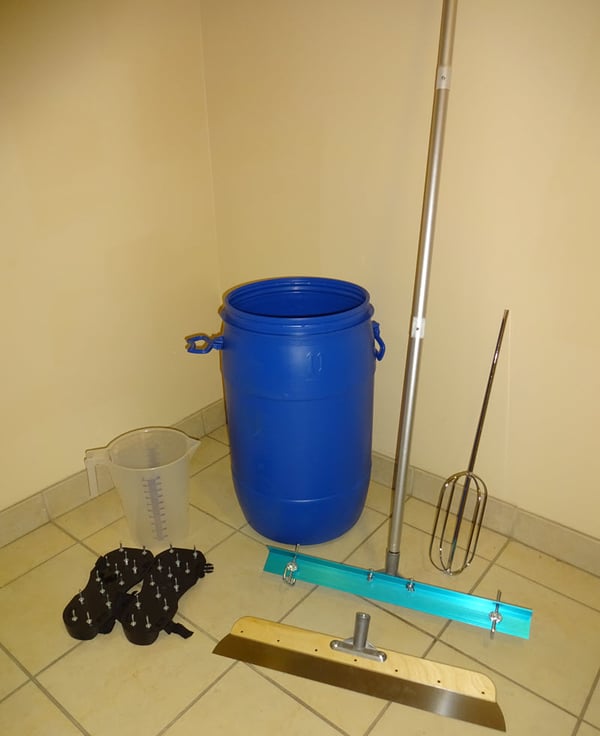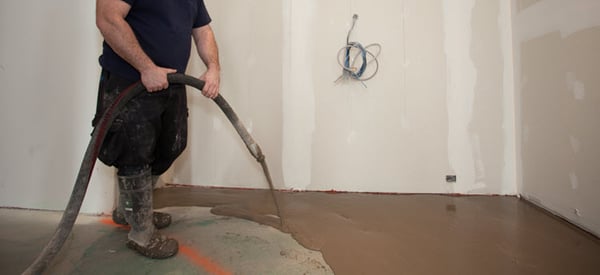 Are you familiar with SLU or Self-Leveling Underlayment?
Are you familiar with SLU or Self-Leveling Underlayment?
This product is a great and quick way to flatten most horizontal surfaces prior to installing large format tile (LFT). To be successful with it, you'll want to address five critical SLU requirements.
The Challenge of Large Format Tile (LFT) Installations
As you probably already know, large format tile installations (a tile with any one side greater than 15” in length) require that the floor have no more than 1/8” in 10’ deviation.
That's per the ANSI Specification A108.02-4.1.4.3.1, Subfloor Surfaces:
For tiles with at least one edge 15 in. (0.38m) or longer, the maximum allowable variation is no more than 1/8 in. in 10 ft. (3 mm in 3 m) and no more than 1/16 in. in 2 ft. (1.6 mm in .6 m) from the required plane, when measured from the high points in the surface.
This means that the floor will not have any low spots or “bird bath” areas greater than 1/8” deep when measured from the high points on the floor with a ten foot straight edge.
Most of us know that the floors over which we are asked to set tile are nowhere near 1/8”. In fact, being given a floor within ¼” would be a gift, but most times the floor surface (substrate) is a mess.
If these areas are small, a fast-setting troweled-on patch works really well. But when the area to be flattened is large or looks like the ocean on a rough day, self-leveling underlayments can save you time and money.
Five Self-Leveling Underlayment (SLU) Requirements
So that SLUs can successfully flatten or possibly level a floor surface prior to installing tile, you must ensure that the floor surface is properly prepared and primed with the manufacturer’s recommended product and allowed to dry.
Here are five critical components required to achieve a successful SLU installation.

1. Carefully Read and Follow SLU Manufacturer Recommendations
Reading and following the manufacturer’s recommendations sounds like common sense, but unfortunately some tile placers think they know it all and skip this step.
SLUs are not forgiving if not handled properly, so following the directions to the letter is a must-do.
>> See Do You Ignore Grout Manufacturer Directions? because what works for grouts works for SLUs.
2. Apply the Recommended Primer
When an installer applies thin set or large and heavy tile mortars, s/he must key either one into the substrate with the flat side of the trowel.
With SLUs, nothing is keyed in, so it's even more crucial that you apply the recommended primer.
This is so important that the manufacturers may want to consider packaging the SLU and the primer as a unit. This way the installer doesn’t “forget” to purchase the primer.
3. Accurately Measure the Water Your SLU Requires
SLUs are engineered to use a very specific amount of water.
Using too much or too little water could be a cause for failure. Accurately measuring the water by using a measuring container is a must.
4. Mix the SLU at a Consistent and Proper Speed
Mixing the powder and water at the proper speed and for the recommended amount of time also are a key component for success.
On the subject of time, be sure to have enough help to mix, move, pour, and smooth the product within the allotted time.
5. Use the Proper Self-Leveling Underlayment Tools
Using the proper tools is a no-brainer.
Proper tools makes the job go more quickly and help to ensure a superior finish. The photo above shows all the components of the SLU tool kit including:
- The mixing barrel,
- Mixing paddle,
- Measuring pitcher,
- Gauging rake with handle,
- Finishing smother,
- Spiked sandals.
This combination of knowledge and tools will go a long way in providing quality installations that will stand the test of time.

Learn More About Underlayments & SLUs
By the way, self-leveling or poured underlayments usually fall into one of two categories:
- Gypsum based underlayments
- Cement based underlayments
You can learn more about them by reading The Ultimate Guide to Underlayment for Tile and exploring Floor Underlayments Preparation Materials.
Here's another resource Control Surface Prep Variables for Greater Profitability.
What's Your Experience with Self-Leveling Underlayments?
Do you follow these five SLU requirements? Would you add to this list?
If you aren't yet, consider becoming a Certified Tile Installer,
Thanks for reading.

